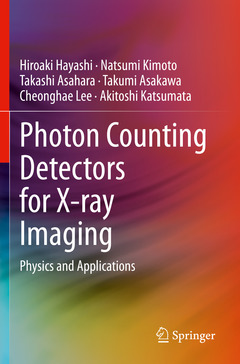Description
Photon Counting Detectors for X-ray Imaging, 1st ed. 2021
Physics and Applications
Authors: Hayashi Hiroaki, Kimoto Natsumi, Asahara Takashi, Asakawa Takumi, Lee Cheonghae, Katsumata Akitoshi
Language: English
Subjects for Photon Counting Detectors for X-ray Imaging:
105.49 €
In Print (Delivery period: 15 days).
Add to cartPublication date: 02-2022
119 p. · 15.5x23.5 cm · Paperback
94.94 €
In Print (Delivery period: 15 days).
Add to cartPublication date: 02-2021
119 p. · 15.5x23.5 cm · Hardback
Description
/li>Contents
/li>Biography
/li>Comment
/li>
This book first provides readers with an introduction to the underlying physics and state-of-the-art application of photon counting detectors for X-ray imaging. The authors explain that a photon-counting imaging detector can realize quantitative analysis because the detector can derive X-ray attenuation information based on the analysis of intensity changes of individual X-ray. To realize this analysis, it is important to consider the physics of an object and detector material. In this book, the authors introduce a novel analytical procedure to create quantitative X-ray images for medical diagnosis.
Generation of X-rays.- Introduction to physics in medical X-ray diagnosis.- Radiation Detector Physics.- Material Identification Method with the Aim of Medical Imaging.- Summary.
Hiroaki Hayashi worked for two years as an assistant professor working for the radioisotope research center at Nagoya University (2005-2011). He specialized in nuclear physics, and his research theme for his doctorate degree was atomic mass measurement by detecting radiations emitted from radioisotopes. After receiving his Ph.D., he moved to Tokushima University as an assistant professor, and changed his research area to radiation physics in medicine (2011-2017). He then moved to Kanazawa University as an associate professor, and has continued to carry out work in the research area (2017-present). His current specialty is radiation physics concerning dosimetry and development of next-generation-type imaging detectors. The physics-based analytical methods described in this book largely depend on his ideas.
Natsumi Kimoto has been performing research with the main theme “development of novel plain X-ray imaging system”, since she was an undergraduate student atTokushima University. After receiving Bachelor's (2016) and Master's (2018) degrees at Tokushima University she moved to a doctorate course at Kanazawa University (2018-present). To extend the use of our method to clinical environments, she has been analyzing several issues using an actual proto-type detector. The knowledge which was acquired through experimentation and simulation studies were presented at various authoritative international conferences such as IEEE and RSNA. At RSNA 2019, her research was awarded a “Certificate of Merit”.
Takashi Asahara earned a Bachelor’s degree in 2017 from Tokushima University. He has been participating in Dr. Hayashi’s Lab since then. After graduation and receiving Bachelor’s degrees in 2017, he entered a Master’s course at Tokushima University. He also started working as a radiological technologist at Okayama University Hospital (2018-present). After earning a Master’s degree in 2019, he entered a doctoral course at Kanazawa Univ




